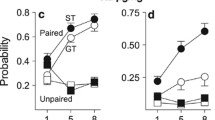Abstract
The present investigation tested the hypothesis that quizapine, a drug thought to act directly or indirectly as an agonist at serotonergic (5-HT) receptors, mimics the stimulus properties of indoleamine and phenethylamine hallucinogens. In a group trained with mescaline (10 mg/kg) and saline in a singlelever response rate task, quipazine yielded intermediate results (58% mescaline-appropriate at 1 mg/kg), i.e., responding was fully appropriate for neither training condition. A second group was then trained with quipazine (3 mg/kg) and saline in a two-lever response choice task. Stimulus control was readily established with a mean of 22 sessions to achieve criterion performance (five consecutive sessions with at least 80% correct responses). When quipazine-trained rats were tested with LSD; responding was intermediate in nature (68% quipazine-appropriate) at a dose of 100 μg/kg but complete substitution was observed at 150 μg/kg (97% quipazine-appropriate). Similarly, subjects trained with LSD and saline in the two lever task and tested with quipazine responded in a fashion indistinguishable from the LSD training condition. The stimulus properties of quipazine alone and in cross tests in mescaline or LSD-trained subjects were blocked by the serotonergic antagonist, BC-105. Butaclamol, a dopaminergic antagonist, and the α-adrenergic antagonist, phentolamine, were without effect upon quipazine. The present data suggest that quipazine produces its stimulus effects by a serotonergic mechanism and that these effects are quite similar to those of LSD and mescaline.
Similar content being viewed by others
References
Barry, H. III, Krimmer, E. C.: Pharmacology of discriminative stimuli. In: Drug discrimination and state dependent learning. B. T. Ho, D. W. Richards, D. L. Chute, eds., pp. 3–32. New York: Academic 1978
Browne, R. G., Ho, B. T.: The role of serotonin in the discriminative stimulus properties of mescaline. Pharmacol. Biochem. Behav. 3, 429–435 (1975)
Conger, J. J.: The effects of alcohol on conflict behavior in the albino rat. Qu. J. Stud. Alcohol. 12, 1–29 (1951)
Frey, L. G., Winter, J. C.: Current trends in the study of drugs as discriminative stimuli. In: Drug discrimination and state dependent learning. B. T. Ho, D. W. Richards, D. Chute, eds. New York: Academic 1978
Grabowska, M., Antikiewicz, L., Michaluk, J.: A possible interaction of quipazine with central dopamine structures. J. Pharm. Pharmacol. 26, 74–76 (1974)
Hamon, M., Bourgoin, S., Enjalbert, A., Bockaert, J., Hery, F., Ternaux, J. P., Glowinski, J.: The effects of quipazine on 5-HT metabolism in the rat brain. Naunyn-Schmiedeberg's Arch. Pharmacol. 294, 99–108 (1976)
Heffter, A.: Über Cacteenalkaloide. Ber. Dtsch. Chem. Ges. 29, 216–233 (1896)
Hirschhorn, I. D., Winter, J. C.: Mescaline and lysergic acid diethylamide (LSD) as discriminative stimuli. Psychopharmacologia 22, 64–71 (1971)
Hong, E., Pardo, E. G.: On the pharmacology of 2-(1-piperazinyl)quinoline. J. Pharmacol. Exp. Ther. 153, 259–265 (1966)
Jacoby, J. H., Howd, R. A., Levin, M. S., Wurtman, R. J.: Mechanisms by which quipazine, a putative serotonin receptor agonist, alters brain 5-hydroxyindole metabolism. Neuropharmacology 15, 529–534 (1976)
Kelleher, R. T., Morse, W. H.: Determinents of the specificity of behavioral effects of drugs. In: Reviews of physiology, biochemistry and experimental pharmacology, Vol 60, pp. 2–56. Berlin-Heidelberg-New York: Springer 1968
Kruse, H.: Thyrotropin releasing hormone: Restoration of oxotremorine tremor in mice. Naunyn-Schmiedeberg's Arch. Pharmacol. 294, 39–45 (1976)
Kuhn, D. M., White, F. J., Appel, J. B.: The discriminative stimulus properties of LSD: Mechanisms of action. Neuropharmacology (in press, 1978)
Malick, J. B., Doren, E., Barnett, A.: Quipazine-induced head-twitch in mice. Pharmacol. Biochem. Behav. 6, 325–329 (1977)
Medon, P. J., Leeling, J. L., Phillips, B. M.: Influence of quipazine, a potential antiparkinsonian agent on the uptake of 3H-dopamine and 3H-serotonin into rat striatal tissue in vitro. Life Sci. 13, 685–691 (1973)
Quock, R. M., Beal, G. A., Chan, E. L. F.: Quipazine: a serotonergic hyperthermic agent in the rabbit. J. Pharm. Pharmacol. 28, 170–172 (1976)
Rodriguez, R., Rojas-Rameriz, J. A., Druker-Colin, R. R.: Serotonin-like actions of quipazine on the central nervous system. Eur. J. Pharmacol. 24, 164–171 (1973)
Schechter, M. D., Rosecrans, J. A.: Lysergic acid diethylamide (LSD) as a discriminative cue: Drugs with similar stimulus properties. Psychopharmacologia 26, 313–316 (1972)
Stoll, A., Hofmann, A.: Partial-Synthese von Alkaloiden vom Typus des Ergobasins (6. Mitteilung über Mutterkorn-Alkaloide). Helv. Chim. Acta 26, 944–957 (1943)
Terrace, H. S.: Stimulus control. In: Operant behavior: Areas of research and application, W. K. Honig, ed., pp. 271–344. New York: Appleton-Century-Crofts 1966
White, F. J., Kuhn, D. M., Appel, J. B.: Discriminative stimulus properties of quipazine. Neuropharmacology 16, 827–832 (1977)
Winer, B. J.: Statistical principles in experimental design, 2nd ed. New York: McGraw-Hill 1971
Winter, J. C.: A comparison of the stimulus properties of mescaline and 2,3,4-trimethoxyphenylethylamine. J. Pharmacol. Exp. Ther. 185, 101–107 (1973)
Winter, J. C.: Blockade of the stimulus properties of mescaline by a serotonin antagonist. Arch. Int. Pharmacodyn. Ther. 214, 250–253 (1975)
Winter, J. C.: Drug-induced stimulus control. In: Contemporary research in behavioral pharmacology, D. E. Blackman and D. J. Sanger, eds., pp. 209–245. New York: Plenum Press 1978a
Winter, J. C.: Stimulus properties of phenethylamine hallucinogens and LSD: The role of 5-hydroxytryptamine. J. Pharmacol. Exp. Ther. 204, 416–423 (1978b)
Author information
Authors and Affiliations
Rights and permissions
About this article
Cite this article
Winter, J.C. Quipazine-induced stimulus control in the rat. Psychopharmacology 60, 265–269 (1979). https://doi.org/10.1007/BF00426666
Received:
Accepted:
Issue Date:
DOI: https://doi.org/10.1007/BF00426666




